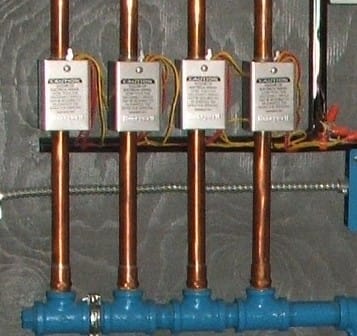 Zone valves and indirect water heaters? I’m guessing most guys would rather drink warm beer than install an indirect with a zone valve. Why? The answers given are usually the standard ones given about zone valves in general, slow recovery, not enough flow, bad practice, no DHW if circulator pump fails but in reality the real answer is the same as it most often is in this industry, “We always do it that way” I felt that way myself, but over the course of years I ran across many jobs with a zone valve on the indirect and, by and large, the customers weren’t complaining. I assumed they thought the reduced performance was normal so I asked them and they proceeded to tell me how long their teenage daughters were in the shower and how happy they were with their decision to buy an indirect. How can this be? After doing a little research, I decided to switch sides!
Zone valves and indirect water heaters? I’m guessing most guys would rather drink warm beer than install an indirect with a zone valve. Why? The answers given are usually the standard ones given about zone valves in general, slow recovery, not enough flow, bad practice, no DHW if circulator pump fails but in reality the real answer is the same as it most often is in this industry, “We always do it that way” I felt that way myself, but over the course of years I ran across many jobs with a zone valve on the indirect and, by and large, the customers weren’t complaining. I assumed they thought the reduced performance was normal so I asked them and they proceeded to tell me how long their teenage daughters were in the shower and how happy they were with their decision to buy an indirect. How can this be? After doing a little research, I decided to switch sides!
We install indirects with zone valves quite frequently and never have an issue. It’s a bit of a long explanation involving a fair bit of math but bear with me. Let’s assume we are installing a new boiler with an indirect utilizing a zone valve. How do you size a pump for an indirect currently? To do it correctly you need to know the head loss of the piping, fittings and heat exchanger as well as the desired flow rate and then choose a pump that will meet the GPM requirements at the head loss of the system. How many people do that? Usually not too many! Most people will choose a 007 or to be on “safe side” a 3-speed pump so they can turn it up. If a pump manufacturer came out with a pump that had four speeds they could be like Spinal Tap!
For an example, lets use a popular 32-gallon indirect with a head loss of 1.9ft and a recommended flow rate of 8 GPM to achieve it’s rated first hour output of 165GPH at a temp rise of 77 F assuming a boiler temperature of 180F. What’s the head loss of the piping? The short formula which works pretty well is as follows.
Total Linear Length x .06 = ft of head
There is approximately 4 feet of head per 100 feet of pipe run, 50% is added to account for fittings which gives us .06. But what about higher resistance devices installed in the piping, like flow valves and zone valves? These have to be accounted for separately and are rated by Cv. What the heck is Cv?
The Cv rating represents that amount of flow needed in order to create a pressure drop of 1PSI, or 2.31 feet of head, across a component like a valve. How do you convert Cv to feet of head? More math, unfortunately!
(Flow in GPM divided by Cv)2 x 2.31 = head loss
Lets use a zone valve with a Cv of 8 in our hypothetical installation, the higher the Cv number the less resistance to flow.
(8 divided by 8) squared = 1 x 2.31 = 2.31 ft/head loss for zone valve
What about the piping? Lets assume we have 25 feet of piping from the boiler to indirect and back. Just a little more math. 25 times .06= 1.2 ft/head
Lets add it all up!
Indirect- 1.9ft
Piping- 1.2 ft
Zone valve 2.3 ft for a total of 5.34 ft/head at 8 GPM. What size pump do we use? Taking a look at a pump curve chart for a circulator that will provide 8 GPM at 5.5 ft/head, a 005 is pretty close but a 007 is a better choice.
What if we used a circulator and weighted flow valve on this job? Everything else would stay the same all we would have to do is swap out the head loss of the zone valve for the flow valve. What is the Cv of a weighted flow valve? A 1” NPT flow valve has a Cv of 6.7, the same valve in sweat is 7.7 Cv. Remember, the higher the Cv the less resistance. The installation with a flow valve actually has a greater head loss than the zone valve job? Yes, it does!
This is how we can use zone valves on indirect water heaters with no homeowner complaints The caveat when using a zone valve on an indirect is domestic priority. Without priority you need to size the circulator for the zone with the largest head loss, which may not be the indirect zone and the flow rate for the all the zones combined.
 Robert C. OBrien is the owner of Technical Heating Co. LLC in Mt. Sinai, NY. Robert serves as the Vice President of the national OESP chapter. See more from Robert in his blog “Boiler Sizing & Indirect Water Heaters” “Heat Loss Calculation on every residential boiler replacement?” & “Converting from Oil to Natural Gas.”
Robert C. OBrien is the owner of Technical Heating Co. LLC in Mt. Sinai, NY. Robert serves as the Vice President of the national OESP chapter. See more from Robert in his blog “Boiler Sizing & Indirect Water Heaters” “Heat Loss Calculation on every residential boiler replacement?” & “Converting from Oil to Natural Gas.”




Join the conversation: